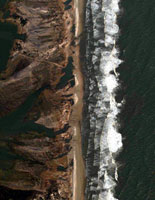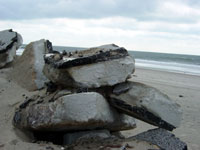Hurricane Isabel caused a significant amount of damage to the mid-Atlantic states when it roared ashore in mid-September 2003. The Outer Banks of North Carolina were hit with a severe tidal surge and many hours of relentless storm pounding. Particularly vulnerable was Ocracoke Island, which lies just east of the path taken by the hurricane’s eye.
 NC 12 is the North Carolina state highway that runs the length of Ocracoke, with NCDOT ferry service being the only way for public transportation to reach the island. On the morning of September 19, it was clear that NC 12 had sustained major damage, and in certain locations was completely undercut and washed away.
NC 12 is the North Carolina state highway that runs the length of Ocracoke, with NCDOT ferry service being the only way for public transportation to reach the island. On the morning of September 19, it was clear that NC 12 had sustained major damage, and in certain locations was completely undercut and washed away.
With NC 12 being the vital lifeline of the Outer Banks, NCDOT needed to act fast to get the highway operational. Making this task more daunting were the logistics of getting construction materials and equipment there by ferry. A plan was needed where a stable road could be constructed by using a minimum amount of material hauled to the site. Asphalt plants and sources of crushed stone were too far away, and would involve too much hauling, which would not only cause logistical problems, but would be extremely expensive.
NCDOT decided to use the material they had plenty of on site – beach sand – and use portland cement to stabilize it into a sturdy roadbed. They did not feel they were taking a risk in making this choice, since a soil-cement base had been used when NC 12 was previously reconstructed in 1991. The road had performed well over the past 12 years, and survived several hurricanes (Emily in 1993, Bertha in 1996, and Dennis and Floyd in 1999).
 Kevin Sebold, a NCDOT Project Engineering Geologist based in Raleigh, was on-site during the construction of the original soil-cement base on Ocracoke in 1991. The decision to use soil-cement again was “primarily based on economics, logistics, and the good performance we’ve had from the old soil-cement base” said Sebold. In fact, the destroyed sections of NC 12 had broken up under Isabel because the entire roadway had been undercut and fractured, not because of erosion of the soil-cement. This fact is evident in viewing pictures of the road debris piles, where the soil-cement is still intact and attached to the asphalt surface.
Kevin Sebold, a NCDOT Project Engineering Geologist based in Raleigh, was on-site during the construction of the original soil-cement base on Ocracoke in 1991. The decision to use soil-cement again was “primarily based on economics, logistics, and the good performance we’ve had from the old soil-cement base” said Sebold. In fact, the destroyed sections of NC 12 had broken up under Isabel because the entire roadway had been undercut and fractured, not because of erosion of the soil-cement. This fact is evident in viewing pictures of the road debris piles, where the soil-cement is still intact and attached to the asphalt surface.
The road reconstruction project involved cement stabilization of approximately 15,000 square yards of road base, built seven inches thick. Seventy-two pounds of portland cement per square yard was selected for construction, the same soil-cement treatment used when the road was reconstructed in 1991. Of course, this necessitated the hauling of nearly 525 tons of cement over the ferries, not to mention the construction equipment.
Site Prep Inc. was contracted to perform the cement stabilization work, but logistics was not the only obstacle.
The beach sand was difficult to work with, since it was very unstable before being treated with cement, and water encroached from both sides.
Fresh water (available from the village of Ocracoke) was used to moisten the sand before the application of cement.
The soil-cement was mixed with a CMI RS-425 (Reclaimer/Stabilizer), followed by grading and compacting.
A larger CMI RS-800 was used in those locations where sections of the old pavement were still intact. In those sections, the old soil-cement base and asphalt surface had to be pulverized with full-depth reclamation, and re-treated with cement. That operation was slow going, even for the 800-horsepower reclaimer.
The soil-cement base was topped with a bituminous surface treatment, which temporarily completed the pavement structure. NCDOT will wait until spring to pave an asphalt surface course, when better supply routes will be operational. NC 12 will be perfectly functional until then, providing the lifeline needed for the Outer Banks of North Carolina.